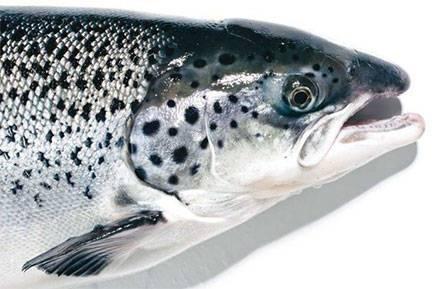
One of the world’s largest seafood producers, Canada, has had its share of struggles with preserving several of its salmon species. Therefore, almost 30 years ago, scientists at a university and later a biotech company thought it would be a great idea to fuse together some genes from a couple species of salmon, rigorously test these fish for safety and nutrition, and finally, gain regulatory approval so this salmon could be sold to consumers.
As a result, AquaBounty has recently sold five tons of their salmon across Canada at an average of a relatively affordable US$5.30 a pound. And the Massachusetts-based company says they are producing this meat much more efficiently. According to the Guardian, this genetically modified (GMO) salmon can reach adult size in 18 months as opposed to 30 months; requires 75 percent less feed than similarly-sized salmon; and has a carbon footprint 1/25th the size of conventionally-grown fish.
AquaBounty’s salmon is not yet available in the U.S., but two years ago, the Food and Drug Administration (FDA) concluded that the fish is safe to eat. The agency, however, has also banned the sale and import of GMO fish until clear labeling guidelines have been written and approved.
But because the Canadian government found that this genetically modified salmon is as nutritious and safe to eat as any wild or farmed alternative, regulators decided no special labeling was needed.
Opponents of GMOs, naturally, are not too pleased. “The first-genetically modified animal is on the market, and consumers in Quebec and Canada will unknowingly become the first guinea pigs,” sniffed Thibault Rehn with the Vigilance OGM, a Quebec-based NGO that is “concerned” about potential impacts GMOs could have on public health.
Other NGOs have also cried foul over the sales of this product, despite the fact that in recent years, the World Health Organization, the Royal Society of Medicine, the National Academy of Sciences, top academic institutions such as Harvard University as well as the American Medical Association have all insisted that they have reviewed the science – none of which, they all concluded, shows any evidence that GMOs are unsafe. The roster of countries home to health and medical organizations that agree there is no evidence GMOs are harmful include Australia, France, Germany, Mexico, New Zealand and the United Kingdom.
Nevertheless, a stubborn public has been convinced that the opposite is true, even though scientists are almost united in their belief that GMOs are safe, just as researchers are overall aligned when it comes to the subject of climate change. A Pew Research survey two years ago found that 57 percent of Americans believe GMOs are unsafe to eat. Meanwhile, the foibles of Monsanto have not helped the biotechnology sector; the marketing campaigns of retailers such as Whole Foods and Trader Joe’s have also skewed this argument.
Current public sentiment may be throwing a wrench in AquaBounty’s plans, but that is not stopping the company from further investing in land-based aquaculture. Earlier this year, the company acquired an aquaculture facility in Indiana, which the company says is integral as the U.S. currently imports over 90 percent of the farmed Atlantic salmon consumed across the country.
Although the company had another net loss last quarter, AquaBounty can ride two trends strongly in its favor, provided investors can stay committed: statistics and the science. The World Resources Institute says the world will need to boost the amount of food calories 70 percent from 2006 levels if we are to feed a global population of 9 billion in 2050. And as the global middle class continues to grow, The United Nation’s Food and Agriculture Program (FAO) says meat consumption will have to expand by two-thirds from 2011 levels to keep pace with demand.
Even though farmers and ranchers have become far more efficient in producing food the past several decades, new ways of producing foods that are safe will have to be considered. Genetically modified salmon that goes from the fish farm to fork will be only one piece of that complicated puzzle.
Image credit: AquaBounty

Leon Kaye has written for 3p since 2010 and become executive editor in 2018. His previous work includes writing for the Guardian as well as other online and print publications. In addition, he's worked in sales executive roles within technology and financial research companies, as well as for a public relations firm, for which he consulted with one of the globe’s leading sustainability initiatives. Currently living in Central California, he’s traveled to 70-plus countries and has lived and worked in South Korea, the United Arab Emirates and Uruguay.
Leon’s an alum of Fresno State, the University of Maryland, Baltimore County and the University of Southern California's Marshall Business School. He enjoys traveling abroad as well as exploring California’s Central Coast and the Sierra Nevadas.














